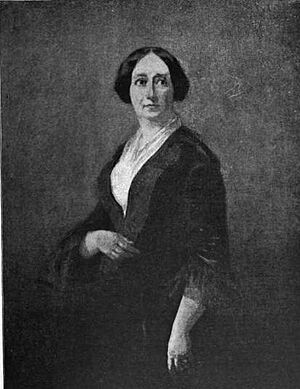Thaddeus Leavitt facts for kids
Thaddeus Leavitt (born September 9, 1750 – died 1826) was an American businessman. He made a better version of the cotton gin, a machine that separates cotton fibers from their seeds. He also joined seven other men from Connecticut to buy a huge area of land called the Western Reserve in Ohio. Some of his family later moved there and helped start Leavittsburg, Ohio.
Leavitt also helped solve arguments about borders between Massachusetts and Connecticut. He was a director of one of Connecticut's first banks. As a shipowner, his ships traveled all over the Atlantic Ocean, trading goods. He even kept a diary where he wrote about everything from the weather to old "cures" and when the United States Constitution was approved.
Contents
Early Life of Thaddeus Leavitt
Thaddeus Leavitt was born on September 9, 1750, in Suffield, Connecticut. His father, John Leavitt, was a farmer and carpenter. His mother was Abiah (née Kent) Leavitt.
Thaddeus Leavitt's Career
Leavitt became a successful businessman in Suffield. He was also a selectman (a local government official) and a Justice of the Peace (a local judge). People often called him 'Squire Leavitt'. He owned a store in Suffield and started investing in shipping early on.
Leavitt became one of the most important people in Hartford County. He earned a lot of money as a merchant and shipowner. His ships sailed to places as far away as the West Indies. He bought goods from other countries and sold American goods abroad. Because he became so wealthy, Leavitt built a large house in Suffield, which was later known as the Harmon House.
Buying Land in the West
Eventually, Leavitt's business reached as far as Spain. He used his growing profits to team up with seven other important men from Connecticut. They bought the Western Reserve lands from the state of Connecticut. The state sold this land to raise money for education. Thaddeus Leavitt and other Suffield businessmen like Oliver Phelps, Gideon Granger, Luther Loomis, and Asahel Hatheway owned a quarter of all the land Connecticut had in the Western Reserve.
Other powerful men in Connecticut also invested in the Connecticut Land Company. One of these investors was Oliver Ellsworth, a relative of Leavitt's. Ellsworth was the Chief Justice of the United States Supreme Court and helped write the United States Constitution. His share of the land was over 41,000 acres, which included much of what is now Cleveland. Thaddeus's brother, John Leavitt, was one of the first people to settle in the Western Reserve. John's family later became very important citizens in Ohio.
Solving Border Disputes
In 1803, Leavitt was chosen to help solve a disagreement between Connecticut and Massachusetts about their border. Suffield, where Thaddeus Leavitt's ancestor had settled, was once considered part of Massachusetts. Leavitt was one of several people asked to help fix this long-running border problem between the two New England states.
Leavitt's involvement in the border commission was connected to his business interests. In 1805, he joined with others to form a company called "The Proprietors of the Springfield Bridge." Their goal was to build a bridge over the Connecticut River connecting West Springfield and Springfield, Massachusetts.
Banking and Agriculture
Within Connecticut, Leavitt also became involved in the state's growth. He was one of the first directors of the new Hartford Bank, which later became the Hartford National Bank. Leavitt even had a hand in farming, serving on a committee for the Hartford County Agricultural Society.
Leavitt's Diary
Even though he was a busy businessman, Leavitt kept a detailed diary. It recorded events in Suffield and nearby areas. Today, this diary is kept at the Kent Memorial Library in Suffield. In his diary, Leavitt wrote about daily life. For example, on December 1, 1802, he noted a cure for whooping cough. He also wrote about a cure for a spider bite and instructions for removing a film from a horse's eye. Leavitt also mentioned the building of a new Meeting house. On February 8, 1788, he wrote about an important event: "We this day have certain Inteligence [sic] from the state convention Boston Massachusetts that they have adopted the Feaderal Constitution by a Majority in favr of it of 19--passd 5th Inst." This means he learned that Massachusetts had approved the U.S. Constitution.
Thaddeus Leavitt's Family Life

Thaddeus Leavitt married Elizabeth King. She was the daughter of Ensign William King and Lucy Hatheway. They received a special piece of French furniture with a brass plaque to celebrate their marriage.
Thaddeus and Elizabeth had two children:
- Thaddeus Leavitt Jr., who also became a businessman in Suffield. He married Jemima Loomis.
- Elizabeth Leavitt, who married Jemima's brother, Luther Loomis.
Thaddeus Leavitt is buried in the Old Burying Ground of the First Congregational Church of Suffield. This church was founded in 1698.
Descendants of Thaddeus Leavitt
Leavitt's great-grandsons included the three Hunt brothers:
- Richard Morris Hunt, a famous architect.
- William Morris Hunt, a well-known painter from Boston.
- Leavitt Hunt, a lawyer and pioneer in photography.
See also
- Hunt family of Vermont
- John Leavitt (Ohio settler)
- Oliver Ellsworth
- Henry Leavitt Ellsworth
- Richard Morris Hunt
- William Morris Hunt
- Leavitt Hunt
- Western Reserve
- Leavittsburg, Ohio


